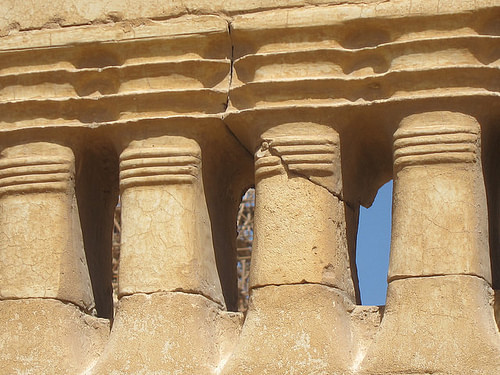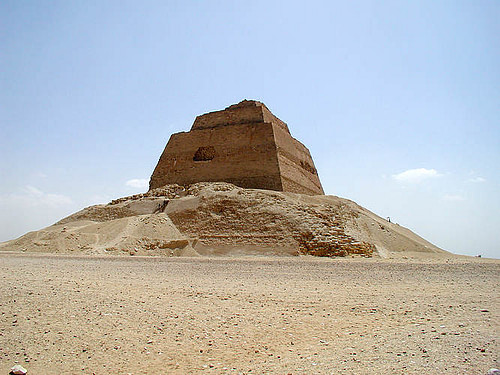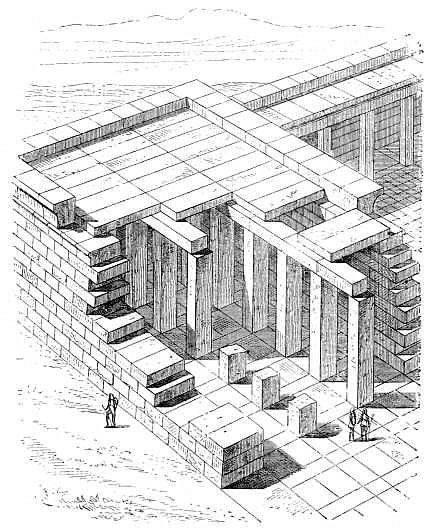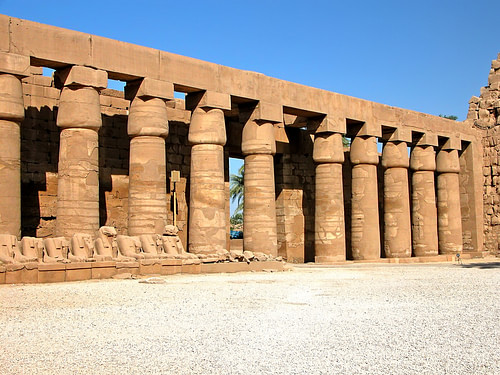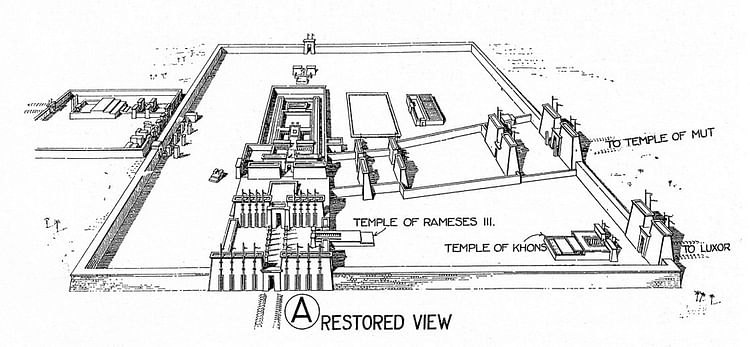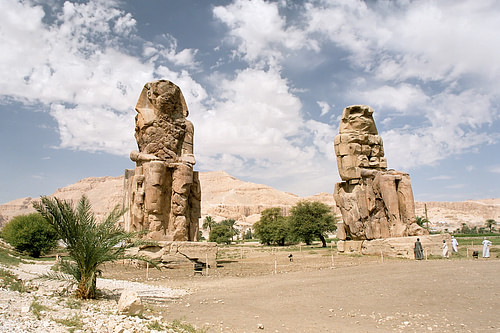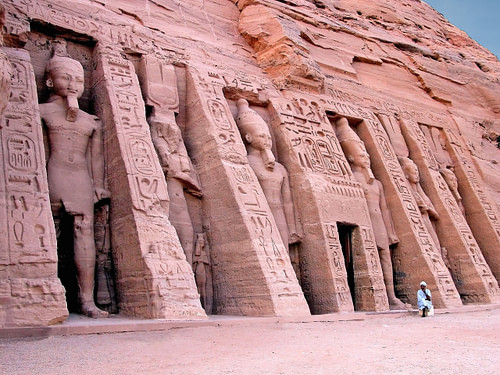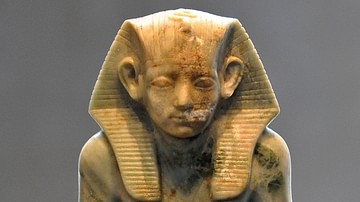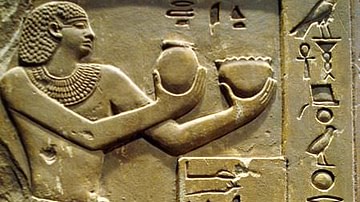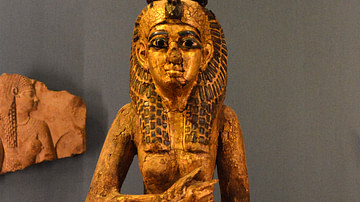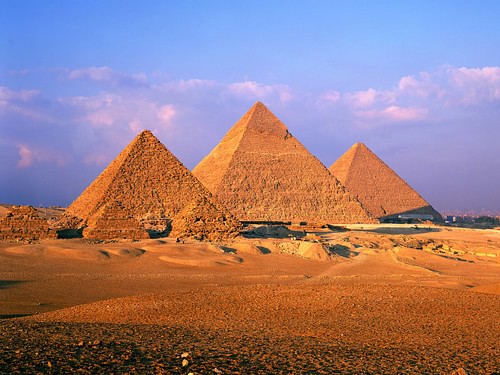
Ancient Egyptian Architecture is often associated closely with the pyramids of Giza but was actually quite diverse, taking a number of forms in the construction of administrative buildings, temples, tombs, palaces, and the private homes of nobility and commoner. Ornamentation of these various structures also varied according to their purpose and the resources of the builder.
Even so, the pyramids are the most recognizable symbol of ancient Egypt. Even though other civilizations, such as the Maya or the Chinese, also employed this form, the pyramid in the modern day is synonymous in most people's minds with Egypt. The pyramids at Giza remain impressive monuments thousands of years after they were built and the knowledge and skill required to construct them was gathered over the many centuries prior to their construction.
Yet the pyramids are not the apex of ancient Egyptian architecture; they are only among the earliest and best known expressions of a culture which would go on to create buildings, monuments, and temples just as intriguing.
6,000 Years of History
Ancient Egyptian history begins prior to the Predynastic Period (c. 6000 - 3150 BCE) and continues through the end of the Ptolemaic Dynasty (323 - 30 BCE). Artifacts and evidence of overgrazing of cattle, in the area now known as the Sahara Desert, date human habitation in the area to c. 8000 BCE. The Early Dynastic Period in Egypt (c. 3150 - 2613 BCE) built upon the knowledge of those who had gone before and Predynastic art and architecture was improved on.
The first pyramid in Egypt, Djoser's Step Pyramid at Saqqara, comes from the end of this Early Dynastic Period and a comparison of this monument and its surrounding complex with the mastaba tombs of earlier centuries show how far the Egyptians had advanced in their understanding of architectural design and construction. Equally impressive, however, is the link between these great monuments and those which came after them.
The pyramids at Giza date from the Old Kingdom (c. 2613 - 2181 BCE) and represent the pinnacle of talent and skill acquired at that time. Ancient Egyptian history, however, still had a long and illustrious path before it and as the pyramid form was abandoned the Egyptians focused their attention on temples. Many of these whose ruins are still extant, such as the temple complex of Amun-Ra at Karnak, inspire as much genuine awe as the pyramids at Giza but all of them, however great or modest, show an attention to detail and an awareness of aesthetic beauty and practical functionality which makes them masterpieces of architecture. These structures still resonate in the present day because they were conceived, designed, and raised to tell an eternal story which they still relate to everyone who visits the sites.
Egyptian Architecture & the Creation Of The World
At the beginning of time, according to the Egyptian religion, there was nothing but swirling waters of dark chaos. From these primordial waters rose a mound of dry land, known as the ben-ben, around which the waters rolled. Upon the mound lighted the god Atum who looked out over the darkness and felt lonely; so he mated with himself and creation began.
Atum was responsible for the unknowable universe, the sky above, and the earth below. Through his children he was also the creator of human beings (though in some versions the goddess Neith plays a part in this). The world and all that human beings knew came from water, from dampness, moistness, from the kind of environment familiar to the Egyptians from the Nile Delta. Everything had been created by the gods and these gods were ever-present in one's life through nature.
When the Nile River overflowed its banks and deposited the life-giving soil the people depended upon for their crops it was the work of the god Osiris. When the sun set in the evening it was the god Ra in his barge going down into the underworld and the people gladly participated in rituals to make sure he would survive attacks from his nemesis Apophis and rise again the next morning. The goddess Hathor was present in the trees, Bastet kept women's secrets and protected the home, Thoth gave people the gift of literacy, Isis, although a great and powerful goddess, had also been a single mother who raised her young son Horus in the swamps of the Delta and watched over mothers on earth.
The lives of the gods mirrored those of the people and the Egyptians honored them in their lives and through their works. The gods were thought to have provided the most perfect of worlds for the people of ancient Egypt; so perfect, in fact, that it would last forever. The afterlife was simply a continuation of the life one had been living. It is not surprising, then, that when these people constructed their great monuments they would reflect this belief system. The architecture of ancient Egypt tells this story of the people's relationship with their land and their gods. The symmetry of the structures, the inscriptions, the interior design, all reflect the concept of harmony (ma'at) which was central to the ancient Egyptian value system.
The Predynastic & Early Dynastic Periods
In the Predynastic Period in Egypt images of the gods and goddesses appear in sculpture and ceramics but the people did not yet have the technical skill to raise massive structures to honor their leaders or deities. Some form of government is evident during this period but it seems to have been regional and tribal, nothing like the central government which would appear in the Old Kingdom of Egypt.
The homes and tombs of the Predynastic Period were built of mud-brick which was dried in the sun (a practice which would continue throughout Egypt's history). Homes were thatched structures of reeds which were daubed with mud for walls prior to the discovery of brick making. These early buildings were circular or oval before bricks were used and, after, became square or rectangular. Communities gathered together for protection from the elements, wild animals, and strangers and grew into cities which encircled themselves with walls.
As civilization advanced, so did the architecture with the appearance of windows and doors braced and adorned by wooden frames. Wood was more plentiful in Egypt at this time but still not in the quantity to suggest itself as a building material on any large scale. The mud brick oval home became the rectangular house with a vaulted roof, a garden, and courtyard. Work in mud brick is also evidenced in the construction of tombs which, during the Early Dynastic Period in Egypt, become more elaborate and intricate in design. These early oblong tombs (mastabas) continued to be built of mud brick but already at this time people were working in stone to create temples to their gods. Stone monuments (stelae) begin to appear, along with these temples, by the Second Dynasty of Egypt (c. 2890 - c. 2670 BCE).
Obelisks, large upright stone monuments with four sides and a tapered top, began to appear in the city of Heliopolis at about this time. The Egyptian obelisk (known to them as tekhenu, "obelisk" being the Greek name) is among the most perfect examples of Egyptian architecture reflecting the relationship between the gods and the people as they were always raised in pairs and it was thought that the two created on earth were mirrored by two identical pieces raised in the heavens at the same time. Quarrying, carving, transporting, and raising the obelisks required enormous skill and labor and taught the Egyptians well how to work in stone and move immensely heavy objects over many miles. Mastering stonework set the stage for the next great leap in Egyptian architecture: the pyramid.
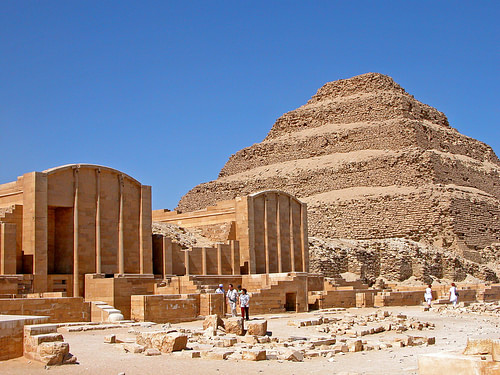
Djoser's mortuary complex at Saqqara was conceived by his vizier and chief architect Imhotep (c. 2667 - c. 2600 BCE) who imagined a great mastaba tomb for his king built of stone. Djoser's pyramid is not a "true pyramid" but a series of stacked mastabas known as a "step pyramid". Even so, it was an incredibly impressive feat which had never been achieved before. Historian Desmond Stewart comments on this:
Djoser's Step Pyramid at Saqqara marks one of those developments that afterward seem inevitable but that would have been impossible without an experimenting genius. That the royal official Imhotep was such a genius we know, not from Greek legend, which identified him with Aesculapius, the god of medicine, but from what archaeologists have discovered from his still impressive pyramid. Investigation has shown that, at every stage, he was prepared to experiment along new lines. His first innovation was to construct a mastaba that was not oblong, but square. His second concerned the material from which it was built. (cited in Nardo, 125)
Temple construction, albeit on a modest level, had already acquainted the Egyptians with stonework. Imhotep imagined the same on a grand scale. The early mastabas had been decorated with inscriptions and engravings of reeds, flowers, and other nature imagery; Imhotep wanted to continue that tradition in a more durable material. His great, towering mastaba pyramid would have the same delicate touches and symbolism as the more modest tombs which had preceded it and, better yet, these would all be worked in stone instead of dried mud. Historian Mark van de Mieroop comments on this:
Imhotep reproduced in stone what had been previously built of other materials. The facade of the enclosure wall had the same niches as the tombs of mud brick, the columns resembled bundles of reed and papyrus, and stone cylinders at the lintels of doorways represented rolled-up reed screens. Much experimentation was involved, which is especially clear in the construction of the pyramid in the center of the complex. It had several plans with mastaba forms before it became the first Step Pyramid in history, piling six mastaba-like levels on top of one another...The weight of the enormous mass was a challenge to the builders, who placed the stones at an inward incline in order to prevent the monument breaking up. (56)
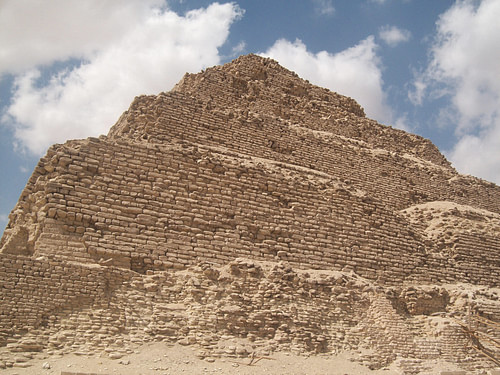
When completed, the Step Pyramid rose 204 feet (62 meters) high and was the tallest structure of its time. The surrounding complex included a temple, courtyards, shrines, and living quarters for the priests covering an area of 40 acres (16 hectares) and surrounded by a wall 30 feet (10.5 meters) high. The wall had 13 false doors cut into it with only one true entrance cut in the south-east corner; the entire wall was then ringed by a trench 2,460 feet (750 meters) long and 131 feet (40 meters) wide.
The actual tomb of Djoser was located beneath the pyramid at the bottom of a shaft 92 feet (28 meters) long. The tomb chamber itself was encased in granite but, to reach it, one had to traverse a maze of hallways, all brightly painted with reliefs and inlaid with tiles, leading to other rooms or dead ends filled with stone vessels carved with the names of earlier kings. This labyrinth was created, of course, to protect the tomb and grave goods of the king but, unfortunately, it failed to keep out ancient grave robbers and the tomb was looted at some point in antiquity.
Djoser's Step Pyramid incorporates all of the elements most resonant in Egyptian architecture: symmetry, balance, and grandeur which reflected the core values of the culture. Egyptian civilization was based upon the concept of ma'at (harmony, balance) which was decreed by their gods. The architecture of ancient Egypt, whether on a small or large scale, always represented these ideals. Palaces were even built with two entrances, two throne rooms, two receiving halls in order to maintain symmetry and balance in representing both Upper and Lower Egypt in the design
The Old Kingdom & the Pyramids
The innovations of Imhotep were carried further by the kings of the 4th Dynasty in the Old Kingdom. The last king of the Third Dynasty of Egypt, Huni (c. 2630 - 2613 BCE), was long thought to have initiated the massive building projects of the Old Kingdom in constructing the pyramid at Meidum but that honor is due the first king of the 4th Dynasty, Sneferu (c. 2613 - 2589 BCE). Egyptologist Barbara Watterson writes, "Sneferu initiated the golden age of the Old Kingdom, his most notable achievements being the two pyramids built for him at Dahshur" (50-51). Sneferu began his work with the pyramid at Meidum now referred to as the "collapsed pyramid" or, locally, as the "false pyramid" because of its shape: it resembles a tower more than a pyramid and its outer casing rests around it in a gigantic heap of gravel.
The pyramid of Meidum is the first true pyramid constructed in Egypt. A "true pyramid" is defined as a perfectly symmetrical monument whose steps have been filled in to create seamless sides tapering toward a point at the top. Originally, any pyramid began as a step pyramid. The Meidum pyramid did not last, however, because modifications were made to Imhotep's original pyramid design which resulted in the outer casing resting on a sand foundation rather than rock, causing it to collapse. Scholars are divided on whether the collapse occurred during construction or over a longer period of time.
Sneferu's experiments with the stone pyramid form served his successor well. Khufu (2589 - 2566 BCE) learned from his father's experiments and directed his administration in constructing the Great Pyramid of Giza, the last of the original Seven Wonders of the Ancient World. Contrary to the popular belief that his monument was built by Hebrew slaves, Egyptian workers on the Great Pyramid were well cared for and performed their duties as part of a community service, as paid laborers, or during the time when the Nile's flood made farming impossible. Scholars Bob Brier and Hoyt Hobbs note:
Were it not for the two months every year when the Nile's water covered Egypt's farmland, idling virtually the entire workforce, none of this construction would have been possible. During such times, a pharaoh offered food for work and the promise of a favored treatment in the afterworld where he would rule just as he did in this world. For two months annually, workmen gathered by the tens of thousands from all over the country to transport the blocks a permanent crew had quarried during the rest of the year. Overseers organized the men into teams to transport the stones on sleds, devices better suited than wheeled vehicles to moving weighty objects over shifting sand. A causeway, lubricated by water, smoothed the uphill pull. No mortar was used to hold the blocks in place, only a fit so exact that these towering structures have survived for 4,000 years - the only Wonders of the Ancient World still standing today. (17-18)
There is no evidence whatsoever that Hebrew slaves, or any kind of slave labor, went into the construction of the pyramids at Giza, the city of Per-Ramesses, or any other important site in Egypt. The practice of slavery certainly existed in Egypt throughout its history, as it did in every ancient culture, but it was not the kind of slavery popularly depicted in fiction and film based on the biblical Book of Exodus. Slaves in the ancient world could be tutors and teachers of the young, accountants, nursemaids, dance instructors, brewers, even philosophers. Slaves in Egypt were either captives from military campaigns or those who could not pay their debts and these people usually worked in the mines and quarries.
The men and women who worked on the Great Pyramid lived in state-provided housing on the site (as discovered by Lehner and Hawass in 1979 CE) and were well compensated for their efforts. The more skilled a worker was, the higher their compensation. The result of their work still amazes people in the modern day. The Great Pyramid of Giza is the only wonder left of the Seven Wonders of the ancient world and justifiably so: until the Eifel Tower was completed in 1889 CE, the Great Pyramid was the tallest structure on earth built by human hands. Historian Marc van de Mieroop writes:
The size boggles the mind: it was 146 meters high (479 feet) by 230 meters at the base (754 feet). We estimate that it contained 2,300,000 blocks of stone with an average weight of 2 and 3/4 tons some weighing up to 16 tons. Khufu ruled 23 years according to the Turin Royal Canon, which would mean that throughout his reign annually 100,000 blocks - daily about 285 blocks or one every two minutes of daylight - had to be quarried, transported, dressed, and put in place...The construction was almost faultless in design. The sides were oriented exactly toward the cardinal points and were at precise 90-degree angles. (58)
The second pyramid constructed at Giza belongs to Khufu's successor Khafre (2558 - 2532 BCE) who is also credited with creating the Great Sphinx of Giza. The third pyramid belongs to his successor Menkaure (2532 - 2503 BCE). An inscription from c. 2520 BCE relates how Menkaure came to inspect his pyramid and assigned 50 of the workers to the new task of building a tomb for his official, Debhen. Part of the inscription reads, "His majesty commanded that no man should be taken for any forced labour" and that rubbish should be cleared from the site for construction (Lewis, 9). This was a fairly common practice at Giza where the kings would commission tombs for their friends and favored officials.
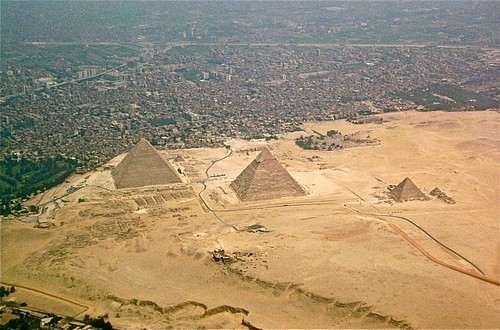
The Giza plateau today presents a very different image from what it would have looked like in the time of the Old Kingdom. It was not the lonely site at the edge of the desert it is today but a sizeable necropolis which had shops, factories, markets, temples, housing, public gardens, and numerous monuments. The Great Pyramid was sheathed in an outer casing of gleaming white limestone and rose from the center of the small city, visible from miles around.
Giza was a self-sustaining community whose people were government workers but the construction of the enormous monuments there in the 4th Dynasty was very costly. Khafre's pyramid and complex are a little smaller than Khufu's and Menkaure's smaller than Khafre's and this is because, as 4th Dynasty pyramid building continued, resources dwindled. Menkaure's successor, Shepsekhaf (2503 - 2498 BCE) was buried in a modest mastaba at Saqqara.
The cost of the pyramids was not only financial but political. Giza was not the only necropolis in Egypt at the time and all of these sites required maintenance and administration which was carried out by priests. As these sites grew, so did the wealth and power of the priests and the regional governors (nomarchs) who presided over the different districts the sites were in.
The later rulers of the Old Kingdom built temples (or pyramids on a much smaller scale) as these were more affordable. The shift from the pyramid monument to the temple signaled a deeper shift in sensibilities which had to do with the growing power of the priesthood: monuments were no longer being built to honor a certain king but for a specific god.
First Intermediate Period & Middle Kingdom
The power of the priests and nomarchs, along with other factors, brought about the collapse of the Old Kingdom. Egypt then entered the era known as the First Intermediate Period (2181 - 2040 BCE) in which individual regions essentially governed themselves. The kings still ruled from Memphis but they were ineffectual.
The First Intermediate Period of Egypt has traditionally been depicted as a time of decline because no great monuments were raised and the quality of the art is considered inferior to that of the Old Kingdom. Actually, though, the artwork and architecture is simply different, not sub-par. In the Old Kingdom, architectural works were state-sponsored, as was artwork, and so was more or less uniform to reflect the tastes of royalty. In the First Intermediate Period, regional artists and architects were free to explore different forms and styles. Historian Margaret Bunson writes:
Under the nomarchs, architecture survived the collapse of the Old Kingdom. Their patronage continued into the Middle Kingdom, resulting in such remarkable sites as Beni Hassan (c. 1900 BC) with its rock carved tombs and large chapels complete with columned porticos and painted walls. (32)
When Mentuhotep II (c. 2061 - 2010 BCE) united Egypt under Theban rule, royal commissioning of art and architecture resumed but, unlike in the Old Kingdom, variety and personal expression was encouraged. Middle Kingdom architecture, beginning with Mentuhotep's grand mortuary complex at Deir el-Bahri near Thebes, is at once grand and personal in scope.
Under the reign of king Senusret I (c. 1971 - 1926 BCE), the great Temple of Amun-Ra at Karnak was begun when this monarch erected a modest structure at the site. This temple, like all Middle Kingdom temples, was constructed with an outer courtyard, columned courts which led to halls and ritual chambers, and an inner sanctum which housed a god's statue. Sacred lakes were created at these sites and the entire effect was a symbolic representation of the beginning of the world and the harmonious operation of the universe. Bunson writes:
Temples were religious structures considered the "horizon" of a divine being, the point at which the god came into existence during creation. Thus, each temple had a link to the past, and the rituals conducted within its court were formulas handed down for generations. The temple was also a mirror of the universe and a representation of the Primeval Mound where creation began. (258)
Columns were an important aspect of the symbolism of a temple complex. They were not designed only to support a roof but to contribute their own meaning to the whole work. Some of the many different designs were the papyrus bundle (a tighly carved column resembling papyrus reeds); the lotus design, popular in the Middle Kingdom of Egypt, with a capital opening like a lotus flower; the bud column whose capital appears to be an unopened flower, and the Djed column which is probably most famous from the Heb Sed Court at Djoser's pyramid complex but was so widely used in Egyptian architecture it can be found from one end of the country to the other. The Djed was an ancient symbol for stability and frequently used in columns either at the base, at the capital (so it appears the Djed is holding up the sky), or as an entire column.
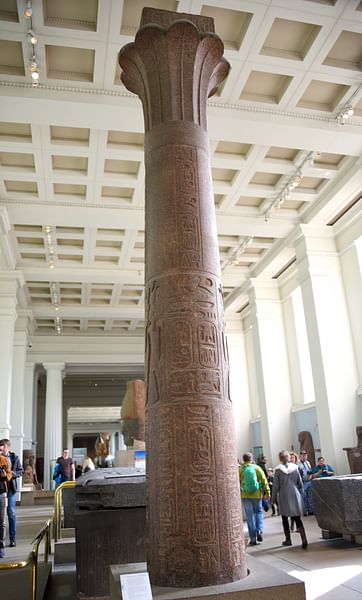
Homes and other buildings continued to be made from mud brick during the Middle Kingdom; stone was only used for temples and monuments and this was usually limestone, sandstone or, in some cases, granite which required the greatest skill to work in. A little known masterpiece of the Middle Kingdom, long ago lost, was the pyramid complex of Amenemhat III (c. 1860 - 1815 BCE) at the city of Hawara.
This complex was enormous, featuring twelve great separate courts which faced one another across an expanse of columned halls and interior hallways so intricate that it was called "the labyrinth" by Herodotus. The courts and hallways were further connected by corridors and colonnades and shafts so that a visitor might walk down a familiar hall but take an unfamiliar turn and wind up in a completely different area of the complex than the one they had intended.
Criss-crossing alleys and false doors sealed by stone plugs served to confuse and disorient a visitor to protect the central burial chamber of the pyramid of the king. This chamber is said to have been cut from a single block of granite and to have weighed 110 tons. Herodotus claimed it was more impressive than any of the wonders he had ever seen.
Second Intermediate Period & New Kingdom
Kings like Amenemhat III of the 12th Dynasty made great contributions to Egyptian art and architecture and their policies were continued by the 13th Dynasty. The 13th Dynasty, however, was weaker and ruled poorly so that, eventually, the power of the central government declined to the point where a foreign people, the Hyksos, rose in Lower Egypt while the Nubians took portions of land to the south. This era is known as the Second Intermediate Period of Egypt (c. 1782 - 1570 BCE) in which there was little advancement in the arts.
The Hyksos were driven from Egypt by Ahmose I of Thebes (c. 1570 - 1544 BCE) who then secured the southern borders from the Nubians and initiated the era known as the New Kingdom of Egypt (1570 - 1069 BCE). This period saw some of the most magnificent architectural feats since the Old Kingdom. In the same way that modern visitors are awed and intrigued by the mystery of how the pyramids at Giza were built, so are they by Hatshepsut's funerary complex, the Temple of Amun at Karnak, the many works of Amenhotep III, and the magnificent constructs of Ramesses II such as Abu Simbel.
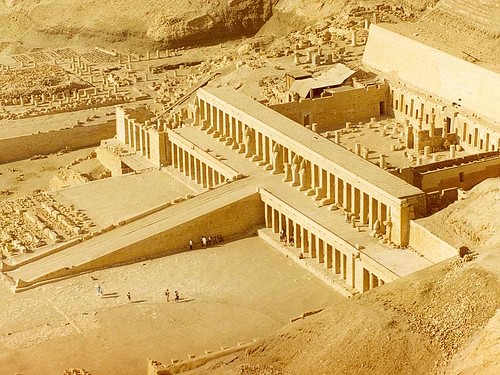
The rulers of the New Kingdom built on a grand scale in keeping with Egypt's new elevated status as an empire. Egypt had never known a foreign power like the Hyksos taking control of their land and, after Ahmose I drove them out, he initiated military campaigns to create buffer zones around Egypt's borders. These areas were expanded by his successors, most notably Thutmose III (1458 - 1425 BCE), until Egypt ruled an empire which stretched from Syria, down the Levant, across to Libya, and down through Nubia. Egypt became immensely wealthy during this time and that wealth was lavished on temples, mortuary complexes, and monuments.
The greatest of these is the Temple of Amun-Ra at Karnak. As with all the other temples in Egypt, this one told the story of the past, the people's lives, and honored the gods but was an immense work-in-progress with every ruler of the New Kingdom adding to it. The site covers over 200 acres and is comprised of a series of pylons (monumental gateways which taper towards the top to cornices), leading into courtyards, halls, and smaller temples.
The first pylon opens onto a wide court which invites the visitor further. The second pylon opens onto the Hypostyle Court which measures 337 feet (103 meters) by 170 feet (52 meters). The hall is supported by 134 columns 72 feet (22 meters) tall and 11 feet (3.5 meters) around in diameter. Scholars estimate one could fit three structures the size of Notre Dame Cathedral inside the main temple alone. Bunson comments:
Karnak remains the most remarkable religious complex ever built on earth. Its 250 acres of temples and chapels, obelisks, columns, and statues built over 2,000 years incorporate the finest aspects of Egyptian art and architecture into a great historical monument of stone. (133)
As with all other temples, Karnak is a paragon of symmetrical architecture which seems to rise organically from the earth toward the sky. The great difference between this structure and any other is its grand scale and the scope of the vision. Each ruler who contributed to the building made greater advances than their predecessors but acknowledged those who had gone before.
When Thutmose III built his festival hall there he may have removed monuments and buildings of earlier kings whom he then acknowledged with an inscription. Every temple symbolizes Egyptian culture and belief but Karnak does so in large letters and, quite literally, through inscriptions. Thousands of years of history may be read on the walls and columns of the Karnak temple.
Hatshepsut (1479 - 1458 BCE) contributed to Karnak like every other ruler but also commissioned buildings of such beauty and splendor that later kings claimed them as their own. Among her grandest is her mortuary temple at Deir el-Bahri near Luxor which incorporates every aspect of New Kingdom temple architecture on a grand scale: a landing stage at the water's edge, flagstaffs (relics of the past), pylons, forecourts, hypostyle halls, and a sanctuary. The temple is constructed in three tiers reaching 97 feet (29.5 meters) and visitors are still amazed by the building in the present day.
Amenhotep III (1386 - 1353 BCE) built so many monuments throughout Egypt that early scholars credited him with an exceptionally long reign. Amenhotep III commissioned over 250 buildings, monuments, stele, and temples. His mortuary complex was guarded by the Colossi of Memnon, two figures 70 feet (21.3 m) high and each weighing 700 tons. His palace, now known as Malkata, covered 30,000 square meters (30 hectares) and was elaborately decorated and furnished throughout the throne rooms, apartments, kitchens, libraries, conference rooms, festival halls, and all the other rooms.
Although Amenhotep III is famous for his opulent reign and monumental building projects, the later pharaoh Ramesses II (1279 - 1213 BCE) is even more well known. Unfortunately this is largely because he is so often equated with the unnamed pharaoh in the biblical Book of Exodus and his name has become recognizable through film adaptations of the story and the incessant repetition of the line from Exodus 1:11 that Hebrew slaves built his cities of Pithom and Per-Ramesses.
Long before the author of Exodus ever came up with his story, however, Ramesses II was famous for his military exploits, efficient rule, and magnificent building projects. His city of Per-Ramesses ("City of Ramesses") in Lower Egypt was widely praised by Egyptian scribes and foreign visitors but his temple at Abu Simbel is his masterpiece. The temple, cut from solid rock cliffs, stands 98 feet (30 meters) high and 115 feet (35 meters) long with four seated colossi flanking the entrance, two to each side, depicting Ramesses II on his throne; each one 65 feet (20 meters) tall.
Beneath these giant figures are smaller statues (still larger than life) depicting Ramesses' conquered enemies, the Nubians, Libyans, and Hittites. Further statues represent his family members and various protecting gods and symbols of power. Passing between the colossi, through the central entrance, the interior of the temple is decorated with engravings showing Ramesses and Nefertari paying homage to the gods.
Abu Simbel is perfectly aligned with the east so that, twice a year on 21 February and 21 October, the sun shines directly into the inner sanctum to illuminate statues of Ramesses II and the god Amun. This is another aspect of ancient Egyptian architecture which characterizes most, if not all, of the great temples and monuments: celestial alignment. From the pyramids at Giza to the Temple of Amun at Karnak, the Egyptians oriented their buildings according to the cardinal points and in keeping with celestial events.
The Egyptian name for a pyramid was Mer, meaning "Place of Ascension" (the name "pyramid" comes from the Greek word pyramis meaning "wheat cake" which is what they thought the structures looked like) as it was believed that the shape of the structure itself would enable the dead king to rise toward the horizon and more easily begin the next phase of his existence in the afterlife. In this same way, temples were oriented to invite the god to the inner sanctum and also, of course, provide access for when they wanted to ascend back to their own higher realms.
Late Period & Ptolemaic Dynasty
The New Kingdom declined as the priests of Amun at Thebes acquired greater power and wealth than the pharaoh while, at the same time, Egypt came to be ruled by weaker and weaker kings. By the time of the reign of Ramesses XI (c. 1107 - 1077 BCE) the central government at Per-Ramesses was completely ineffective and the high priests at Thebes held all the real power.
The Late Period of Ancient Egypt is characterized by invasions by the Assyrians and the Persians prior to the arrival of Alexander the Great in 331 BCE. Alexander is said to have designed the city of Alexandria himself and then left it to his subordinates to build while he continued on with his conquests. Alexandria became the jewel of Egypt for its magnificent architecture and grew into a great center of culture and learning. The historian Strabo (63 BCE - 21CE) praised it on one of his visits, writing:
The city has magnificent public precincts and royal palaces which cover a fourth or even a third of the entire area. For just as each of the kings would, from a love of splendour, add some ornament to the public monuments, so he would provide himself at his own expense with a residence in addition to those already standing. (1)
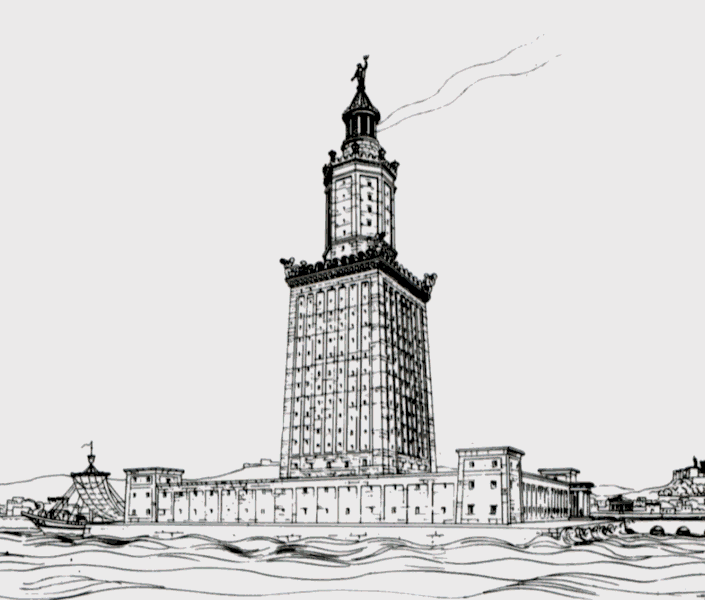
Alexandria became the impressive city Strabo praises during the time of the Ptolemaic Dynasty (323 - 30 BCE). Ptolemy I (323 - 285 BCE) began the great Library of Alexandria and the temple known as the Serapeum which was completed by Ptolemy II (285 - 246 BCE) who also built the famous Pharos of Alexandria, the great lighthouse which was one of the Seven Wonders of the World.
The early rulers of the Ptolemaic Dynasty continued the traditions of Egyptian architecture, blending them with their own Greek practices, to create impressive buildings, monuments, and temples. The dynasty ended with the death of the last queen, Cleopatra VII (69 - 30 BCE), and the country was annexed by Rome.
The legacy of the Egyptian architects lives on, however, through the monuments they left behind. The imposing pyramids, temples, and monuments of Egypt continue to inspire and intrigue visitors in the present day. Imhotep and those who followed after him envisioned monuments in stone which would defy the passage of time and keep their memory alive. The enduring popularity of these structures today rewards that early vision and accomplishes their goal.
